I couldn’t come to Kerala without doing what nearly every other visitor to this state of India does – and that is spend a night on a houseboat.
The Kuttanad backwaters are located to the south of Kochi and cover an area of over a million hectares, of which about 50,000 ha are below sea level. It is a lush, green labyrinth of canals, lakes, waterways, levees, islands, coconut groves and paddy fields.
There are over 300 houseboats that ply the canals on day and day/night trips that enable tourists to see something of the lifestyle of the 1.8 million people who live in Kuttanad. Most of the houseboats are based at Alleppy – about an hour and a half’s drive south of Kochi – and the day/night trips leave at 12 noon and return at 9.00 am the next day.
Some of the houseboats are old converted rice barges, but many have been built more recently to meet the demands of the expanding tourist trade. However, nearly all have been built using the same traditional materials as the old rice barges – anjili wood for the hull and bamboo, palm leaves and coir for the canopy – and constructed by hand using no nails.

Some of the houseboats are very luxurious with two or three air-conditioned bedrooms, a dining room and a satellite.
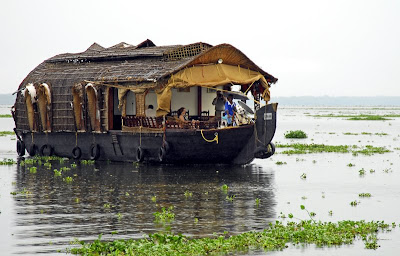
Others are more basic, and a few looked like they were in need of repairs – the canopy of the one in the picture above seemed to be falling apart.
I stayed on quite a small one, but it still had a crew of three – the captain, a deckhand and a cook.
After leaving Alleppy we cruised for about an hour before stopping by the side of a canal for lunch. We tied up at a levee where a rice farmer was building a small house. Whilst having lunch I watched them unload two piles of sand from a large canoe. They did it all by hand using plastic buckets – they didn’t even have a shovel.
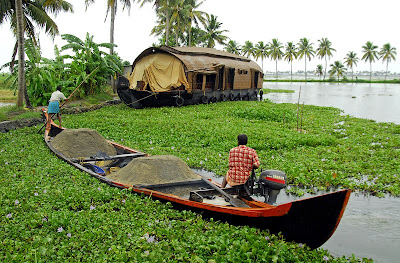

After lunch we continued cruising the labyrinth of waterways watching the local people going about their daily lives – everyone here travels either by boat or by foot along the levees. It was raining most of the day, so wasn’t the best for photography, but at least the rain kept the temperature down to a pleasantly cool 24-25 degrees.
Apart from the houseboats, the waterways are busy with the public transport vessels (ferries and launches) that provide services between the towns and villages as well as lots of small craft like canoes and basket boats.
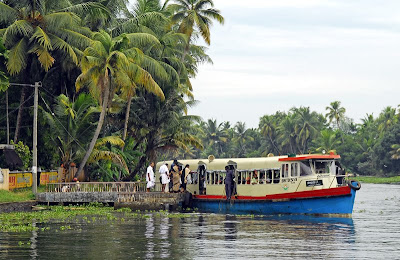
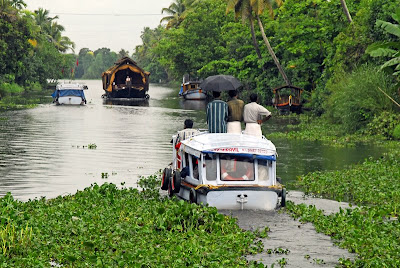

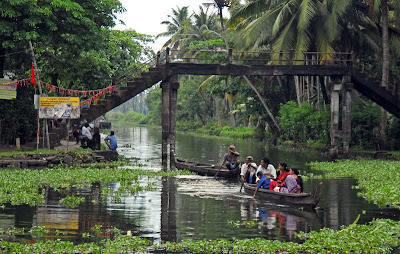
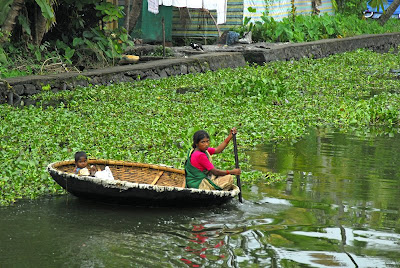
The basket boats looked more difficult to paddle than the canoes which most people were using - especially when trying to get through the water hyacinth that chokes many of the waterways.
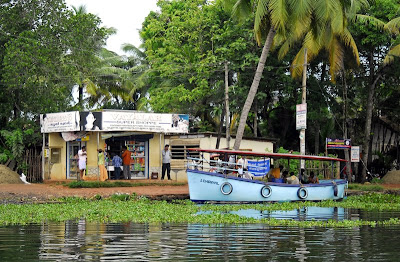
This is one of the local shops that you see along the waterways.
Along the way we saw many styles of local housing.
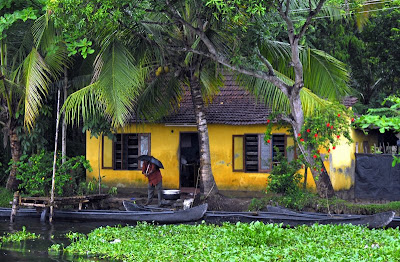
The house in the picture above is fairly typical of the types of houses you will see along the Kuttanad waterways – most will have one or two canoes tied up in front. This house had six or seven – so maybe they were entertaining visitors.

Some people live in much more basic conditions though.
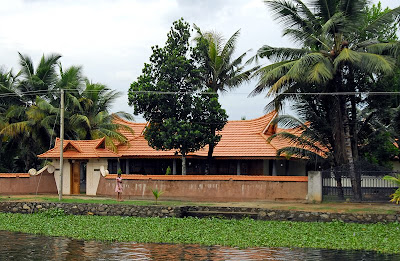
Occasionally you will see a few luxury houses where obviously wealthier people are living. As is often the case in India, you see very rich people living right alongside very poor people.
During the afternoon I bought some large freshwater prawns from a fisherman who had come up alongside my boat. He was wearing a shower cap to protect himself from the light drizzle (not a very macho fisherman I thought!).
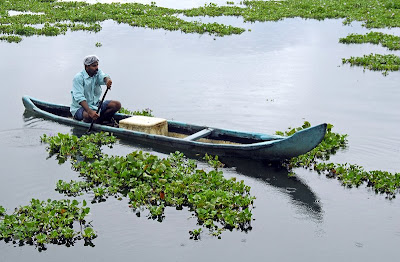

I asked the cook on board to prepare them for dinner. I bought a kilo for 900 rupees (about US$22.50) – expensive for India, but they were worth every rupee (I couldn’t eat them all so shared them with the crew).
The prawns were as fresh as fresh can be, and the cook grilled them in a delicious spicy paste that made me rate them as probably the best prawns I have ever eaten. The cook told me that he had made the paste from ginger, garlic, tumeric, fish marsala and garam marsala. He served them up with a delicious array of Indian dishes – I had not expected the food to be so good on a houseboat.
Lunch and dinner were both excellent, although breakfast was very basic (an omelette and some bread). But I enjoyed the experience. The cost was quite reasonable – 6,000 rupees (about US$150) given that it included three meals (same price for one or two people) and that I was being attended to by a crew of three. I gave each of the crew a 500 rupees tip when we got back to Alleppy, and they seemed very happy with that.
